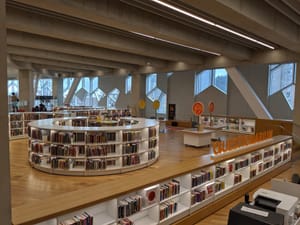Blogging has been a little light of late, as I have had a lot going on – including the writing of my contribution to the Ariadne 10th anniversary issue. Here is the conclusion to that article, which looks at changes in the network environment in which libraries operate. Given the nature of Ariadne there is some focus on academic libraries.
At the end of the Ariadne decade, we are still looking at change.
I have suggested that there is a neat coincidence in that each end of the decade
falls at a significant moment. The first saw the convergence of the Web and
broad-based connectivity to create a new social space for research and learning.
The second, whether one wants to use the Web 2.0 label or not, involves the
convergence of the programmable Web and connectivity which is broadband and
wireless. It is the age of Amazoogle. I have discussed some of the system changes
in the flat network world, how research and learning behaviours are changing
as they become meshed with the network, and what some of these things mean for
library services. In summary, I have emphasised three broad issues:
- Much of our work, learning and research activity is being reshaped in a network environment. This will have a profound effect on library services. In fact, the effect of technology on research and learning behaviours will have a greater impact than the direct effect of technology on library systems and services themselves. In the medium term, the library will need to engage with major shifts in research and learning practice. In the short term, the library needs to begin building services around user workflows, supporting the remix of content and services in user environments, and developing digital curation services.
- The network has created a new dynamic of discovery and use around major hubs of information infrastructure: Google, Amazon, iTunes and so on. They have aggregated supply (unified discovery and reduced transaction costs), aggregated demand (brought a large audience to bear), and are developing into platforms which help other applications reach their goals. These will not replace library services, but they have caused us to think about how to deliver service on the Web. Although the collective library resource is deep, fragmentation of discovery and high transaction costs have reduced impact. Libraries are exploring how better to project a targeted service into user environments, how to develop a switch between the open Web and rich library services, and how to make services more engaging.
- It is not possible for every library to support and manage all of its ‘business processes’, especially as the demand on the library grows, and service expectations and technologies change so quickly. Libraries have historically depended on shared platforms for services, and we may be about to see another step change in adoption. The motivation is to remove redundancy and to build capacity through collaboratively sourcing solutions, so as better to focus library effort on where it can make a distinctive local impact on the quality of the research and learning environment.
The notion of the ‘well-found’ library was current in the UK some years ago.
What does it mean to be well-equipped for the job? What is the nature of a library
service that appropriately supports research and learning needs in our current
environment, or a few years hence? Jerry Cambpell, writing in Educause Review,
recently asked this question in different terms.Although these emerging, digital-age library services may be important, even critical, in the present era, there is no consensus on their significance to the future academic library-or even on whether they should remain as library functions carried out by librarians. In addition, at this point, the discussion of the future of the academic library has been limited to librarians and has not widened, as it should, to involve the larger academic community. Consequently, neither academic librarians nor others in the academy have a crisp notion of where exactly academic libraries fit in the emerging twenty-first-century information panoply. [35]
This is an ongoing question as research, learning and information use are reconfigured.



